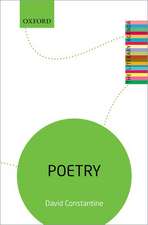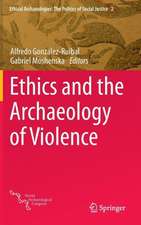Archaeologies of Internment: One World Archaeology
Editat de Adrian Myers, Gabriel Moshenskaen Limba Engleză Paperback – 27 aug 2012
As archaeologists have begun to explore the material remains of internment using a range of methods, these interdisciplinary studies have demonstrated the potential to connect individual memories and historical debates to the fragmentary material remains.
Archaeologies of Internment brings together in one volume a range of methodological and theoretical approaches to this developing field. The contributions are geographically and temporally diverse, ranging from Second World War internment in Europe and the USA to prison islands of the Greek Civil War, South African labor camps, and the secret detention centers of the Argentinean Junta and the East German Stasi.
These studies have powerful social, cultural, political, and emotive implications, particularly in societies in which historical narratives of oppression and genocide have themselves been suppressed. By repopulating the historical narratives with individuals and grounding them in the material remains, it is hoped that they might become, at least in some cases, archaeologies of liberation.
| Toate formatele și edițiile | Preț | Express |
|---|---|---|
| Paperback (1) | 390.25 lei 6-8 săpt. | |
| Springer – 27 aug 2012 | 390.25 lei 6-8 săpt. | |
| Hardback (1) | 397.38 lei 6-8 săpt. | |
| Springer – 27 iun 2011 | 397.38 lei 6-8 săpt. |
Din seria One World Archaeology
-
 Preț: 417.17 lei
Preț: 417.17 lei - 8%
 Preț: 383.64 lei
Preț: 383.64 lei -
 Preț: 358.77 lei
Preț: 358.77 lei -
 Preț: 349.50 lei
Preț: 349.50 lei -
 Preț: 230.66 lei
Preț: 230.66 lei -
 Preț: 498.91 lei
Preț: 498.91 lei -
 Preț: 426.67 lei
Preț: 426.67 lei - 12%
 Preț: 336.21 lei
Preț: 336.21 lei -
 Preț: 389.38 lei
Preț: 389.38 lei - 25%
 Preț: 248.97 lei
Preț: 248.97 lei -
 Preț: 461.86 lei
Preț: 461.86 lei -
 Preț: 475.16 lei
Preț: 475.16 lei -
 Preț: 429.12 lei
Preț: 429.12 lei - 20%
 Preț: 114.19 lei
Preț: 114.19 lei -
 Preț: 406.05 lei
Preț: 406.05 lei - 18%
 Preț: 1061.81 lei
Preț: 1061.81 lei - 23%
 Preț: 329.50 lei
Preț: 329.50 lei - 18%
 Preț: 1345.33 lei
Preț: 1345.33 lei -
 Preț: 388.13 lei
Preț: 388.13 lei -
 Preț: 471.08 lei
Preț: 471.08 lei -
 Preț: 390.63 lei
Preț: 390.63 lei - 18%
 Preț: 1002.68 lei
Preț: 1002.68 lei -
 Preț: 511.20 lei
Preț: 511.20 lei -
 Preț: 472.21 lei
Preț: 472.21 lei - 18%
 Preț: 1010.22 lei
Preț: 1010.22 lei -
 Preț: 416.26 lei
Preț: 416.26 lei - 24%
 Preț: 331.04 lei
Preț: 331.04 lei -
 Preț: 494.48 lei
Preț: 494.48 lei -
 Preț: 402.17 lei
Preț: 402.17 lei - 18%
 Preț: 1062.16 lei
Preț: 1062.16 lei - 15%
 Preț: 470.69 lei
Preț: 470.69 lei -
 Preț: 476.08 lei
Preț: 476.08 lei - 25%
 Preț: 767.47 lei
Preț: 767.47 lei
Preț: 390.25 lei
Nou
Puncte Express: 585
Preț estimativ în valută:
74.68€ • 77.68$ • 61.66£
74.68€ • 77.68$ • 61.66£
Carte tipărită la comandă
Livrare economică 14-28 aprilie
Preluare comenzi: 021 569.72.76
Specificații
ISBN-13: 9781461429012
ISBN-10: 1461429013
Pagini: 332
Ilustrații: XV, 313 p. 8 illus.
Dimensiuni: 155 x 235 x 17 mm
Greutate: 0.47 kg
Ediția:2011
Editura: Springer
Colecția Springer
Seria One World Archaeology
Locul publicării:New York, NY, United States
ISBN-10: 1461429013
Pagini: 332
Ilustrații: XV, 313 p. 8 illus.
Dimensiuni: 155 x 235 x 17 mm
Greutate: 0.47 kg
Ediția:2011
Editura: Springer
Colecția Springer
Seria One World Archaeology
Locul publicării:New York, NY, United States
Public țintă
GraduateCuprins
Chapter 1. An Introduction to Archaeologies of Internment by Gabriel Moshenska and Adrian Myers.- Chapter 2. Exceptional Space: Concentration Camps and Labor Compounds in Late19th Century South Africa by Lindsay Weiss.- Chapter 3. A Tale of Two Treatments: The Materiality of Internment on the Isle of Man in the World Wars by Harold Mytum.- Chapter 4. The Archaeology of Internment in Francoist Spain (1936-1952) byAlfredo González-Ruibal.- Chapter 5. The Things of Auschwitz by Adrian Myers.- Chapter 6. Gordon Hirabayashi, the Tucsonians and the U.S. Constitution:Negotiating Reconciliation in a Landscape of Exile by Mary Farrell and Jeff Burton.- Chapter 7. Control or Repression: Contrasting a Prisoner of War Camp and a WorkCamp from World War Two by Iain Banks.- Chapter 8. Engraving and Embroidering: The Material Culture of Internment by Gillian Carr.- Chapter 9. Archaeological Investigations of WWII Internment Camps at Fort Hood,Texas by Judith Thomas.- Chapter 10. Forgotten in the Wilderness: WWII German POW Camps in Finnish Lapland by Oula Seitsonen and Vesa-Pekka Herva.- Chaper 11. Materialities and Traumatic Memories of a 20th Century Greek Exile Island by Nota Pantzou.- Chapter 12. The Engineering of Genocide: An Archaeology of Dictatorship in Argentina by Andrés Zarankin and Melisa Salerno.- Chapter 13. A Political Archaeology of Latin America’s Recent Past by Gonzalo Compañy, Gabriela González, Leonardo Ovando and David Rossetto.- Chapter 14. Hohenschönhausen: Visual and Material Representations of a Cold War Prison Landscape by John Schofield and Wayne Cocroft.- Chapter 15. The Last Murals of Long Kesh: Fragments of Political Imprisonment at the Maze Prison, Northern Ireland by Louise Purbrick.- Chapter 16. Lockdown: On the Materiality of Confinement by Eleanor Conlin Casella.
Recenzii
Modernity has been characterized by the internment of people, as a way of torturing and sometimes destroying them. Those practices aim at controlling, subduing and forcing people to comply with social norms, punishing deviation and descent with seclusion and possibly death. As a ubiquitous feature of modernity, archaeology has been paying a growing attention to the study of the materiality of internment. Archaeologies of Internment gathers contributors from different continents and aims at understanding a wide variety of experiences worldwide and also at fostering a less oppressive sociability in the present. As a result, the reader is both enlightened and enticed to join the contributors in their struggle for a liberating archaeology. A most readable book, Archaeologies of Internment is a convincing invitation to a renewed practice of the discipline. --Pedro Paulo A. Funari, former World Archaeological Congress secretary, is professor of historical archaeology at Campinas University, Brazil.
Notă biografică
Adrian Myers is a PhD Candidate in the Department of Anthropology at Stanford University. For his dissertation research he is running excavations at a Prisoner of War camp that held German Afrika Korps soldiers in a national park in Canada during the Second World War.
Gabriel Moshenska is a Leverhulme Trust Early Career Research Fellow at UCL Institute of Archaeology. He works on the history of archaeology, public archaeology, and the archaeology and anthropology of Second World War Britain.
Gabriel Moshenska is a Leverhulme Trust Early Career Research Fellow at UCL Institute of Archaeology. He works on the history of archaeology, public archaeology, and the archaeology and anthropology of Second World War Britain.
Textul de pe ultima copertă
The internment of civilian and military prisoners became an increasingly common feature of conflicts in the twentieth century and into the twenty-first. Prison camps, though often hastily constructed and just as quickly destroyed, have left their marks in the archaeological record. Due to both their temporary nature and their often sensitive political contexts, places of internment present a unique challenge to archaeologists and heritage managers.
As archaeologists have begun to explore the material remains of internment using a range of methods, these interdisciplinary studies have demonstrated the potential to connect individual memories and historical debates to the fragmentary material remains.
Archaeologies of Internment brings together in one volume a range of methodological and theoretical approaches to this developing field. The contributions are geographically and temporally diverse, ranging from Second World War internment in Europe and the USA to prison islands of the Greek Civil War, South African labor camps, and the secret detention centers of the Argentinean Junta and the East German Stasi.
These studies have powerful social, cultural, political, and emotive implications, particularly in societies in which historical narratives of oppression and genocide have themselves been suppressed. By repopulating the historical narratives with individuals and grounding them in the material remains, it is hoped that they might become, at least in some cases, archaeologies of liberation.
As archaeologists have begun to explore the material remains of internment using a range of methods, these interdisciplinary studies have demonstrated the potential to connect individual memories and historical debates to the fragmentary material remains.
Archaeologies of Internment brings together in one volume a range of methodological and theoretical approaches to this developing field. The contributions are geographically and temporally diverse, ranging from Second World War internment in Europe and the USA to prison islands of the Greek Civil War, South African labor camps, and the secret detention centers of the Argentinean Junta and the East German Stasi.
These studies have powerful social, cultural, political, and emotive implications, particularly in societies in which historical narratives of oppression and genocide have themselves been suppressed. By repopulating the historical narratives with individuals and grounding them in the material remains, it is hoped that they might become, at least in some cases, archaeologies of liberation.
Caracteristici
Presents a new methodological approach for studying archaeology of internment Sheds light on often overlooked archaeological sites Contains international case studies with broad theoretical applications Includes supplementary material: sn.pub/extras














